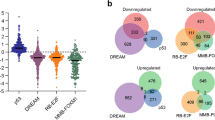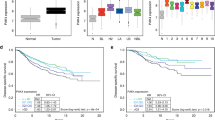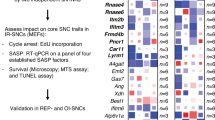Abstract
The tumor suppressor p16INK4a is a potent mediator of cell cycle arrest in transient expression studies, is induced in senescing cells, and can impose morphological features of senescence. Nonetheless, it is unclear whether p16INK4a can block cell proliferation irreversibly. We explored this issue using osteogenic sarcoma cell clones with inducible p16INK4a expression. Induction of p16INK4a for 1 day arrested most cells in G1 phase. If the induction was then interrupted, p16INK4a levels returned to baseline and robust growth resumed within 3–5 days. When p16INK4a was induced for 6 days DNA synthesis remained strongly inhibited and the cells acquired morphological features of senescence. Moreover, if p16INK4a induction was interrupted at this point and the cells were followed for 12 more days, most cells retained these morphologic features and either failed to divide or died. This occurred despite the prompt return of p16INK4a expression and retinoblastoma protein phosphorylation toward baseline levels. In fact, some senescing cells appeared to enter S phase. These results demonstrate that a sustained period of p16INK4a expression is sufficient in this setting to impose a durable block to cell proliferation and that this state becomes independent of p16INK4a expression, hypophosphorylation of pRB, or a strict G1 arrest.
This is a preview of subscription content, access via your institution
Access options
Subscribe to this journal
Receive 50 print issues and online access
$259.00 per year
only $5.18 per issue
Buy this article
- Purchase on Springer Link
- Instant access to full article PDF
Prices may be subject to local taxes which are calculated during checkout








Similar content being viewed by others
References
Alcorta DA, Xiong Y, Phelps D, Hannon G, Beach D and Barret JC . 1996 PNAS 93: 13742–13747
Asamoto M, Hori T, Baba-Toriyama H, Sano M, Takahashi S, Tsuda H and Shirai T . 1998 Cancer Lett 127: 9–13
Atadja P, Wong H, Garkavtsev I, Veillette C and Riabowol K . 1995 PNAS 92: 8348–8352
Baylin SB, Herman JG, Graff JR, Vertino PM and Issa J-P . 1998 Adv Cancer Res 72: 141–196
Brenner AJ, Stampfer MR and Aldaz CM . 1998 Oncogene 17: 199–205
Cohen JA and Geradts J . 1997 Hum Pathol 28: 893–898
Dimri GP, Lee X, Basile G, Acosta M, Scott G, Roskelley C, Medrano EE, Linskens M, Rubeljo I, Pereira-Smith O, Peacock M and Campisi J . 1995 PNAS 92: 9363–9367
Erickson S, Sangfelt O, Heyman M, Castro J, Einhorn S and Grander D . 1998 Oncogene 17: 595–602
Foster SA, Wong DJ, Barrett MT and Galloway DA . 1998 Mol Cell Biol 18: 1793–1801
Geradts J and Wilson PA . 1996 Am J Pathol 149: 15–20
Gire V and Wynford-Thomas D . 1998 Mol Cell Biol 18: 1611–1621
Gossen M and Bujard H . 1992 PNAS 89: 5547–5551
Harkin DP, Bean JM, Miklos D, Song YH, Truong VB, Englert C, Christians FC, Ellisen LW, Maheswaran S, Oliner JD and Haber DA . 1999 Cell 97: 575–586
Higashi H, Suzuki-Takahashi I, Yoshida E, Nishimura S and Kitagawa M . 1997 Biochem Biophys Res Commun 231: 743–750
Jarrard DF, Sarkar S, Shi Y, Yeager TR, Magrane G, Kinoshita H, Nassif N, Meisner L, Newton MA, Waldman FM and Reznikoff CA . 1999 Cancer Res 59: 2957–2964
Kato D, Miyazawa K, Ruas M, Starborg M, Wada I, Oka T, Sakai T, Peters G and Hara E . 1998 FEBS Lett 427: 203–208
Kiyono T, Foster SA, Koop JI, McDougall JK, Galloway DA and Klingelhutz AJ . 1998 Nature 396: 84–88
Koh J, Enders GH, Dynlacht BD and Harlow E . 1995 Nature 375: 506–510
Lukas J, Parry D, Aagarrd L, Mann DJ, Bartkova J, Strauss M, Peters G and Bartek J . 1995 Nature 375: 503–506
Lukas J, Sorensen CS, Lukas C, Santoni-Rugiu E and Bartek J . 1999 Oncogene 18: 3930–3935
McConnell BB, Gregory FJ, Stott FJ, Hara E and Peters G . 1999 Mol Cell Biol 19: 1981–1989
McConnell BB, Starborg M, Brookes S and Peters G . 1998 Curr Biol 8: 351–354
Medema RH, Herrera RE, Lam F and Weinberg RA . 1995 PNAS 92: 6289–6293
Mitra J, Dai CY, Somasundaram K, El-Deiry WS, Satyamoorthy K, Herlyn M and Enders GH . 1999 Mol Cell Biol 19: 3916–3928
Reznikoff CA, Yeager TR, Belair CD, Savelia E, Puthenveetil JA and Stadler WM . 1996 Cancer Res 56: 2886–2890
Rossi FM, Guicherit OM, Spicher A, Kringstein AM, Fatyol K, Blakely BT and Blau HM . 1998 Nature Genet 20: 389–393
Sandig V, Brand K, Herwig S, Lukas J, Bartek J and Strauss M . 1997 Nature Med 3: 313–319
Sayama K, Shirakata Y, Midorikawa K, Hanakawa Y and Hashimoto K . 1999 J Cell Physiol 179: 40–44
Serrano M, Gomez-Lahoz E, DePinho RA, Beach D and Bar-Sagi D . 1995 Science 267: 249–252
Serrano M, Hannon GJ and Beach D . 1993 Nature 366: 704–707
Serrano M, Lee H, Chin L, Cordon-Cardo C, Beach D and DePinho RA . 1996 Cell 85: 27–37
Serrano M, Lin AW, McCurrach ME, Beach D and Lowe SW . 1997 Cell 88: 593–602
Seshadri T and Campisi J . 1990 Science 247: 205–209
Stein GH, Drullinger LF, Soulard A and Dulic V . 1999 Mol Cell Biol 19: 2109–2117
Timmermann S, Hinds PW and Munger K . 1998 Oncogene 17: 3445–3453
Uhrbom L, Nister M and Westermark B . 1997 Oncogene 15: 505–514
Vogt M, Haggblom C, Yeargin J, Christiansen-Weber T and Haas M . 1998 Cell Growth Differ 9: 139–146
Acknowledgements
CY Dai was supported in part by National Research Service Award # 5-T32-GM 07229, for graduate studies in cell and molecular biology. This work was also supported in part by the following grants to GH Enders: a Clinical Investigator Award (7-K08-CA61412) from the National Cancer Institute, a Pilot Project grant from the University of Pennsylvania Comprehensive Cancer Center, an American Cancer Society Institutional Research Grant administered through this Center, and a Research Program Grant (#RPG-99-168-01-CCG) from the American Cancer Society. We also would like to acknowledge use of facilities of the Penn Digestive Disease Center, supported by Center Grant P30 DK50306, and the Cancer Center, supported by grants from the NCI and the Markey Charitable Trust.
Author information
Authors and Affiliations
Rights and permissions
About this article
Cite this article
Dai, C., Enders, G. p16INK4a can initiate an autonomous senescence program. Oncogene 19, 1613–1622 (2000). https://doi.org/10.1038/sj.onc.1203438
Received:
Revised:
Accepted:
Published:
Issue Date:
DOI: https://doi.org/10.1038/sj.onc.1203438
Keywords
This article is cited by
-
Simultaneous expression of MMB-FOXM1 complex components enables efficient bypass of senescence
Scientific Reports (2021)
-
Necdin modulates proliferative cell survival of human cells in response to radiation-induced genotoxic stress
BMC Cancer (2012)
-
The role of p21 in regulating mammalian regeneration
Stem Cell Research & Therapy (2011)
-
Effects of Rhein Lysinate on H2O2-induced cellular senescence of human umbilical vascular endothelial cells
Acta Pharmacologica Sinica (2011)
-
Expression of coxsackie and adenovirus receptor distinguishes transitional cancer states in therapy-induced cellular senescence
Cell Death & Disease (2010)



